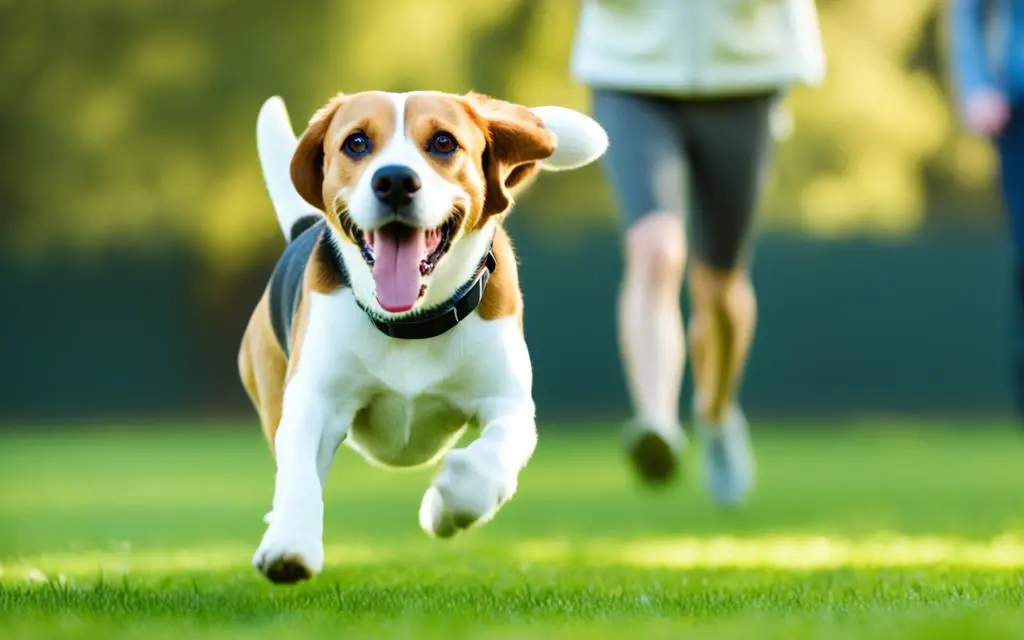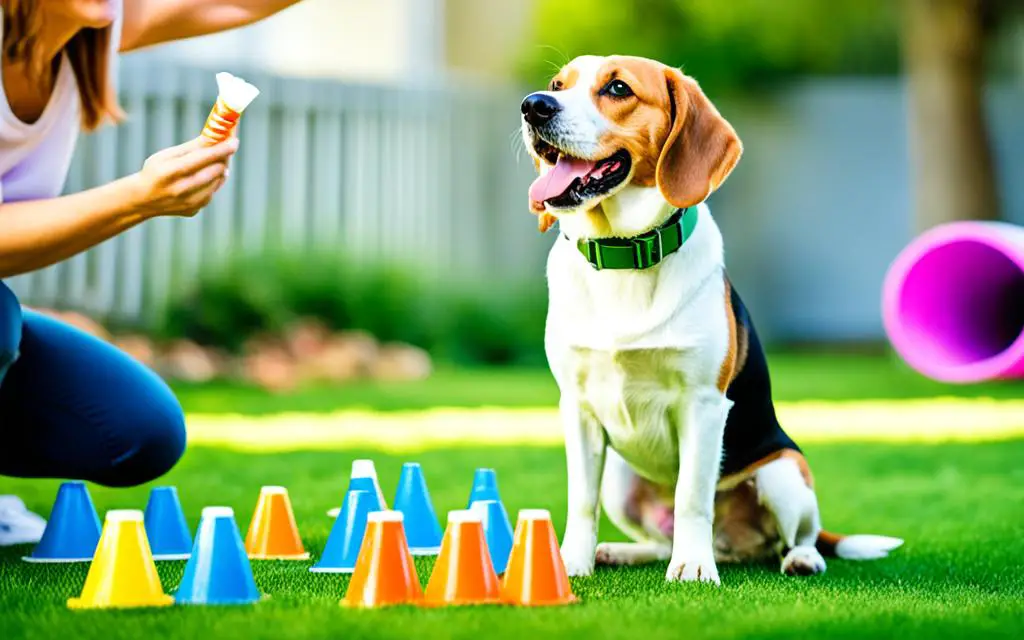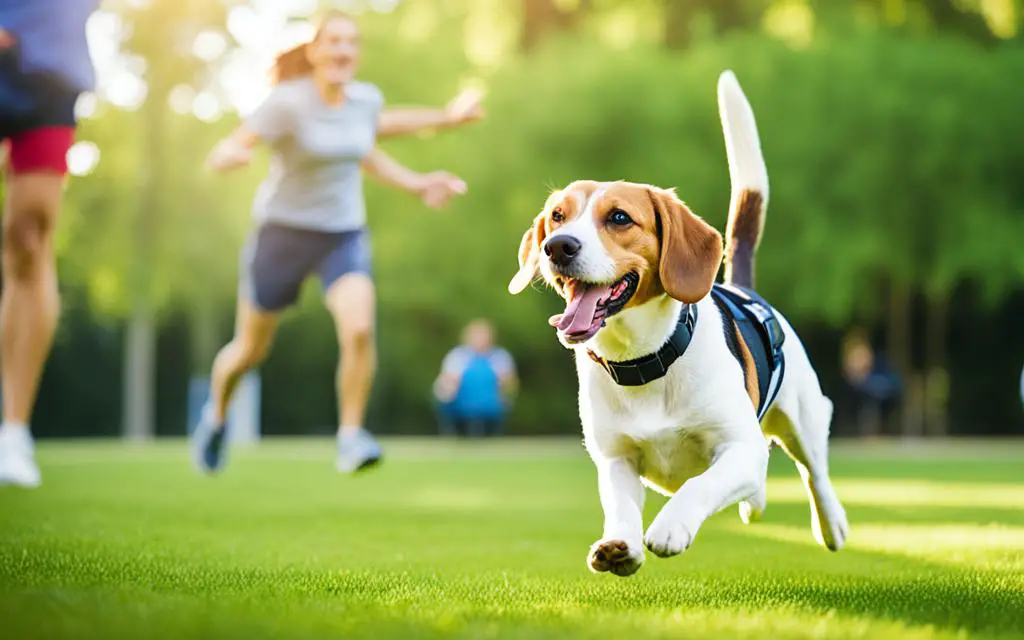Having a well-trained Beagle adds so much joy to your life. They are lovable, energetic, and make great friends. But their strong hunting instinct can lead them away sometimes.
Sarah and her Beagle, Buddy, loved going to the park. Buddy loved to run and explore there. But, Buddy often slipped away, chasing squirrels or birds. Sarah would call out frantically, but Buddy didn’t listen.
Sarah knew she had to act for Buddy’s safety. She learned how to teach Buddy to come when called. Patience, consistency, and rewards were key, she discovered.
Sarah began training Buddy in their quiet backyard. She called “Buddy, come!” in a cheerful voice, showing him a treat. Buddy ran back to her, excited for his reward.
Sarah made the training harder over time, adding more distractions. She always rewarded Buddy for coming back. This made training fun for him. Buddy’s confidence soared with each successful recall.
Now, Buddy is a well-trained dog. He can play off-leash and always returns when Sarah calls. Sarah no longer worries about Buddy running off. They enjoy exploring together, secure in the knowledge that Buddy will return.
Key Takeaways:
- It’s important to teach your Beagle recall for their safety during off-leash activities.
- Begin training in a simple environment and slowly add more challenges.
- Remember, always use positive reinforcement, not punishment, when they come back to you.
- Reward them with their favorite treats and toys to encourage the recall behavior.
- Regularly practice the recall command, gradually making it more difficult to ensure a reliable recall.
The Importance of Reliable Recall
Having your Beagle come back when called is vital. It keeps them safe and lets them play off-leash outside fenced areas. This also means they’ll be secure in emergencies. A reliable recall means your dog runs to you joyfully when called, without pausing.
While dogs aren’t perfect and success isn’t guaranteed, you can greatly better your Beagle’s recall with regular training and proper methods. Teaching your dog that staying close to you is fun and rewarding helps build a trustworthy recall. Through positive associations and reinforcing good behavior, you can make the recall command strong and reliable.
Creating Positive Associations
Improving recall starts with making your Beagle see that being near you is the best. Reward them with their favorite snacks, like chicken bits or freeze-dried liver, when they come to you. Also, use their beloved toys or play as a reward for coming back.
Each time your Beagle follows the recall command, praise them warmly. Show your joy for their return. This makes them link coming back to you with happiness and makes them more willing to return when called.
Consistency and Practice
Being consistent is crucial in recall training. Practice the recall command often, making it part of your daily routine. Begin in places with few distractions, like your backyard, and slowly add more as your Beagle gets better.
Use the recall cue carefully and avoid using it when your dog might ignore it. This keeps the command strong and meaningful, avoiding it becoming ineffective from misuse or negative experiences.
Adding Distance and Distractions
When your Beagle consistently comes in easy settings, start increasing the distance. Call them from further away, bit by bit. Slowly work up to larger distances to strengthen their recall ability.
Begin with easy distractions and slowly introduce tougher ones. This means calling them back even when they’re playing or when tempting smells are around. By slowly upping distractions and staying consistent, you can maintain a reliable recall amid temptations.
Training for a reliable recall demands time, patience, and persistence. Celebrate the progress you make and keep at it. With the right approach and a positive attitude, you’ll improve your Beagle’s recall. This allows them to safely enjoy freedom without a leash.
Training Recall Commands
Train your Beagle to come when called by making it fun. Start in a quiet place like your home. This way, your dog can focus on learning. Use a toy or treat to make them come to you.
Show them the reward and praise them when they come. Give them the treat right away. This teaches them that coming to you is good. Slowly, add more distance and distractions to the mix.
Add recall games to the training. “Catch Me” and “Find Me” are fun ways to learn. They also help your dog understand how to come back to you.
Keep track of your training efforts. Write down how far your dog comes, the distractions, and how they react. This will show where they do well and where they need more help.
Make recall training a game. Use fun games and track your progress. Be patient and celebrate every win. This will help your Beagle learn to come when called reliably.
Alternatives to Off-Leash Play
If you’re worried your dog won’t come when called, think about other play options. Keeping your dog on a leash or in fenced areas helps them explore safely. Always follow local leash rules, even in your yard or parks. Learning commands, like beagle obedience training, is key for dog owners.
The Benefits of On-Leash Activities
On-leash fun with your Beagle has its pluses:
- Increased control: A leash helps you steer your dog, stopping them from straying or risky acts.
- Safety: A leash keeps your Beagle safe in new or strange places, away from dangers like cars or animals.
- Training opportunities: Leash times are great for teaching commands and improving your dog’s behavior in different places.
Utilizing Fenced Areas
Having a secure fenced spot, like a yard or a dog park, is great for your Beagle. They get to move freely but safely, without the danger of them escaping or causing trouble.
Responsible Dog Ownership
Training, including beagle obedience training, is crucial for responsible dog ownership. It ensures your Beagle listens and follows your lead. This makes everyone’s outings more fun.
Avoiding Training Mistakes
When training your Beagle to come when called, avoid common errors that may slow them down. Knowing these mistakes and using the right tactics can boost your recall training success.
Don’t End the Fun
It’s a mistake to stop the fun right after your dog comes by putting them on a leash and leaving. This can make your Beagle see recall as a bad thing. They might not want to come when called. To keep them motivated, offer praise, treats, and playtime as rewards for coming back.
Avoid Repetition
Repeating your recall cue too much can make it less effective. Your Beagle might start to ignore the cue. Use clear commands so your Beagle gets what you mean.
Minimize Distractions
Start recall training in a place with few distractions to help your Beagle succeed. Begin in a quiet area then slowly add more distractions. This helps them concentrate on you and come when called.
Reward Eye Contact
During recall training, encourage your Beagle to look at you. Give them a reward when they do. This strengthens your bond and makes them more likely to respond well later.
Avoid Punishment
Never scold your Beagle for coming back slowly or hesitating. Scolding can make them scared and less willing to come when called. Always use positive reinforcement like praise, treats, and playing instead.
Use High-Value Rewards
To get your Beagle to come when called, offer them something they can’t resist. Use their favorite snacks or toys as rewards. This turns coming back to you into something they look forward to.
Daily Practice
For a better recall, include training in your daily routine. Being consistent helps strengthen the behavior. Make sure you practice recall regularly to keep your Beagle’s skills sharp.

Steer clear of these training errors and use smart strategies to improve your Beagle’s recall. With effective tactics, you can make sure your Beagle’s recall is solid and reliable.
Overcoming Training Challenges
Training a beagle can sometimes feel tough, especially with recall. Don’t worry, though. With the right steps, you can beat these challenges. Here’s how to make your beagle’s recall better.
Change the Verbal Cue
If your dog doesn’t listen to your recall cue, the command might be unclear. Try a new cue that’s fresh and distinct. Pick a phrase or word you’ve not used before. This makes it special to your dog and captures their focus.
Create a Positive Association
It’s key to link the recall command with happy vibes. Make training fun with treats, toys, and praise. This way, your beagle learns that coming to you is the best thing.
Consistency is Key
Being consistent is essential in recall training. Use the same recall phrase and make sure everyone does too. Stick with it, even in different places or when there are distractions. With time, your beagle will reliably come when called.
“The key to training success is patience, persistence, and positive reinforcement.”
Avoid Punishment
Never punish your dog for not coming when called. It could make them scared or not want to come. Use treats, toys, or praise instead. Positive rewards mean they’re more likely to come when you call.
Stay Positive and Motivated
Training for recall can take a while. If your beagle struggles at first, keep a positive attitude. Celebrate the progress and keep going. You might need to change how you train or get help from a pro. With hard work and patience, you’ll improve your beagle’s recall.
Training Tips for Success
To get your Beagle to come back when called, follow these tips:
- Limit repeats: Use the recall command once, clearly and firmly. Saying it more confuses your Beagle and weakens the cue.
- Start simple: Begin training in a quiet place with few distractions, like your yard. Move on to busier places as your dog gets better.
- Give rewards: Immediately praise and treat your Beagle when they come on command. It teaches them that coming back leads to good things.
- Stay positive: Never scold your Beagle for taking their time to come. Punishment can make them scared to return. Keep training upbeat.
- Train daily: Work on recall every day. Make it harder by adding more distance and distractions over time.
- Keep track: Write down how each training session goes. Note what’s hard or easy for your Beagle. This helps you know what to focus on.
In an emergency, like if your Beagle is running towards danger, don’t chase. Run the opposite way to make them follow you. This tactic could save them.
By using these recall training tips, your Beagle will learn to come when called. This makes both of you happier and safer.
Starting Recall Training with a Puppy
Recall training is vital from the start, especially with puppies. By beginning early, puppies learn important skills for coming when called.
Using a whistle or a distinct sound linked to mealtime works well. This teaches your puppy to associate the sound with something good. As a result, your puppy will find coming back when called rewarding.
As your puppy gets better at recall, start to set higher challenges. Try calling them from further away or when they’re distracted. This strengthens their recall skills and ensures they understand what to do.
Begin recall training in a place your puppy knows well, like indoors. When they smoothly respond to calling in quiet places, move to busier places like parks.
During training, make succeeding easy for your puppy. Start with few distractions and slowly add more as they learn. Always have treats or their favorite toy ready to reward them.
Keep practicing recall regularly and maintain the training as your dog gets older. This consistency is crucial for them to always respond to the recall command.
Recall Training with Meals and Whistle Signal
| Training Technique | Description |
|---|---|
| Mealtime Association | Condition your puppy to associate the sound of a whistle or signal with mealtime. Blow the whistle or make the signal immediately before feeding your puppy. |
| Gradual Distance Increase | Once your puppy is familiar with the whistle signal, practice recall at different distances. Start with short distances and gradually increase the distance over time. |
| Distraction Training | Introduce distractions gradually during recall training. Begin in a low-distraction environment and increase the level of distractions as your puppy becomes more proficient. |
| Progressive Environments | Start recall training indoors, then progress to outdoor spaces like the garden or park. This helps your puppy generalize the recall command in different environments. |
| Consistency and Rewards | Consistently reinforce the recall command and reward your puppy with treats or toys for coming when called. This strengthens the desired behavior and creates positive associations. |
Recalling an Older or Rescue Dog
Training an older or rescue dog to come when called is both rewarding and challenging. It’s a myth that older dogs can’t learn new tricks. Using the right techniques, even beagles with a past can master recall.
Using meals as rewards during training is effective. Split your dog’s daily food into small portions for these sessions. When they’re a bit hungry, they’re more eager to learn, which makes training faster.
Consistency is key in recall training, especially in the first two years. Keep practicing the recall command. Increase the training’s difficulty by adding distractions and changing the environment for a reliable recall anywhere.
It’s important to have consequences for both success and failure in training. Reward your dog with praise, treats, or toys for coming when called. But avoid punishment for not responding; it does more harm than good.
The Benefits of Recall Training for Older or Rescue Dogs
“Teaching recall to an older or rescue dog is an incredible opportunity to enhance their sense of security, build trust, and strengthen the bond between you and your pet. A reliable recall allows them to experience the joys of off-leash exploration and provides a safety net during emergencies.”
Recall training isn’t just for puppies. It improves older or rescue dogs’ lives significantly. By teaching recall and fostering a strong relationship, you ensure their safety and freedom.
Lifelong Commitment and Continued Maintenance
“Remember, recall training is not a one-time event; it requires ongoing commitment and maintenance throughout your dog’s life. Consistency, regular practice, and reinforcement will help your older or rescue dog retain their recall skills and respond reliably to your command.”
Keep up with recall training in different settings and scenarios. This regular practice ensures a lifelong bond and obedience for your beagle.

| Benefits of Recall Training for Older or Rescue Dogs | Tips for Successful Recall Training |
|---|---|
| 1. Enhances sense of security | 1. Be consistent and patient |
| 2. Builds trust and strengthens the bond | 2. Use meals/food as rewards for quick results |
| 3. Provides off-leash exploration opportunities | 3. Establish consequences for failure and success |
| 4. Ensures safety during emergencies | 4. Practice in different environments and distractions |
Managing Chasing Behavior
Chasing things like joggers, cyclists, or other animals is something you can fix with good beagle training. It’s very important to keep your dog and everyone else safe. So, never put your beagle in a place where they could mess up.
Begin training your beagle when they are still a puppy. Use controlled situations with help from a friend. This approach lets you slowly make the recall command harder. You can add moving things like toys or snacks.
Work on the recall command when real joggers or cyclists are around. It will make your dog listen better and see following commands as good. This stops them from chasing and makes your bond with your beagle stronger.
Keep a trailing line on your beagle during training until they can reliably come back when called. This gives you extra control. It also stops your beagle from chasing dangerously.
Training Tips:
- Start training from a young age
- Use controlled situations with a partner or helper
- Incorporate moving triggers like toys or food
- Practice recall in real-life scenarios
- Use a trailing line for added control
Conclusion
Teaching your Beagle to come back when called is key to keeping them safe. It also makes off-leash time more fun. Practice recall training steps to help your Beagle listen well.
Begin training in a quiet place like your home, then move to harder places. Always use treats and kind words to encourage them. Never punish them during training.
Being consistent and patient is very important. Remember, teaching recall is an ongoing task. By staying committed, you can help your Beagle respond whenever you call them. Using these methods will let you both enjoy many adventures without a leash.





Leave a Reply